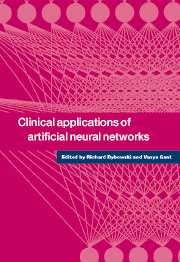14 - Artificial neural networks: practical considerations for clinical application
Published online by Cambridge University Press: 06 October 2009
Summary
Introduction
The past nine years have seen a steady increase in the number of publications concerning artificial neural networks (ANNs) in medicine (Figure 14.1). Many of these demonstrate that neural networks offer equivalent if not superior performance when compared with other statistical methods, and in some cases with doctors, in several areas of clinical medicine. Table 14.1 gives a by no means exhaustive list of academically driven applications, which are notable for their breadth of potential application areas. Despite this academic research portfolio demonstrating success, we know of very few examples of an ANN being used to inform patient care decisions, and few (if any) have been seamlessly incorporated into everyday practice. Furthermore, we know of no randomized clinical trial (RCT) examining the impact of ANN output on clinical actions or patient outcomes. This is in sharp contrast to the 68 RCTs published since 1976 assessing the impact of reminders and other decision support systems, none of them ANNs, on clinical actions and patient outcomes included in Hunt et al.'s (1998) systematic review.
To check whether our personal experience is reflected in the literature, we conducted a search of the Medline bibliographic database in all languages for the period January 1993 to March 2000 using the Medical Subject Headings term ‘Neural-networks- (computer)’. Using the Silver Platter software, this yielded 3101 articles. When filtered using the Medline Publication Type = ‘clinical-trial’, this number plummeted 50-fold to 61 articles.
- Type
- Chapter
- Information
- Clinical Applications of Artificial Neural Networks , pp. 329 - 356Publisher: Cambridge University PressPrint publication year: 2001
- 7
- Cited by



